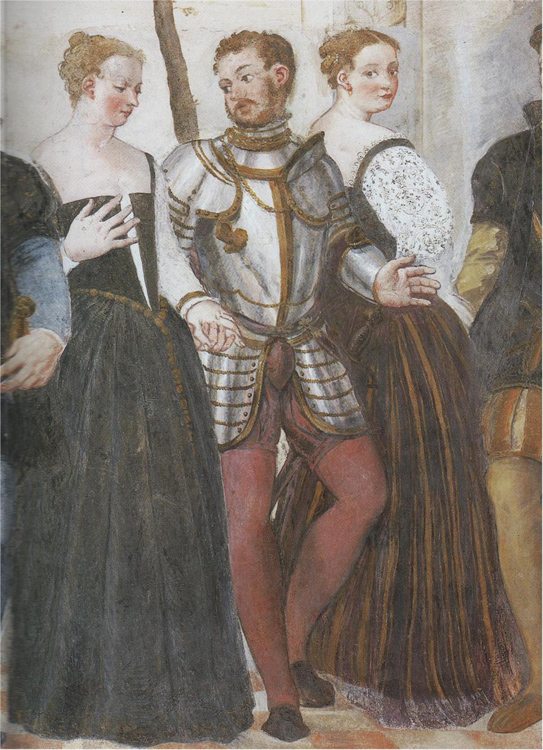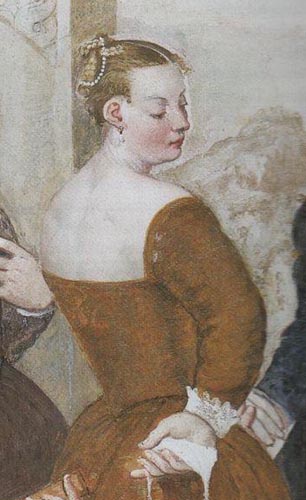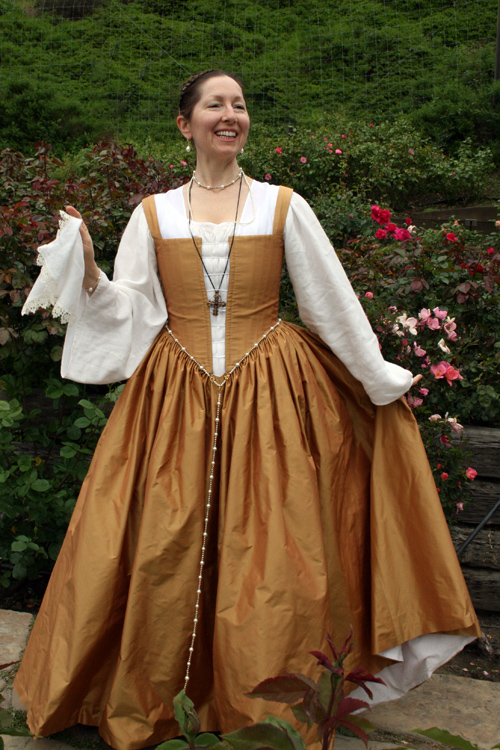
February 2022 – January 2023
For the past few years Italian Renaissance costumes have moved toward the top of my sewing list. This is due to my new interest in early dance, especially late-16th century Italian. I had just read dancing master Caroso’s notes, “The Conduct of a Lady When Dancing” (Nobilta, 1600). He gives instructions to the lady for gracefully maneuvering her skirt’s train and farthingale. This action is to be done without using the hands, while dancing backwards. How baffling. I wanted a trained gown. Granted, it would be impractical at almost any modern ball. The train would need to be kirtled up every time it was worn. On the other hand, Venetian gowns were sometimes worn sleeveless which was very practical. The camicia sleeves are pictured rolled, pinned or tucked up, or simply allowed to hang. My new sleeveless dance dress would be quite comfortable.

Fresco, Villa Caldogno, Caldogno

Fresco, Villa Caldogno, Caldogno



The bodice pattern from my first Venetian was a great starting point. The new bodice is also boned, with a coutil/broadcloth base. Center front has 1/4″ steels to support the lacing, and the rest are cable ties. The bodice is bag lined and the skirt cartridge pleated and whipped on. I put a row of pick stitching through all the layers of the bodice, between the first and second bones. This keeps the lining from pulling out. Stitching lines like this may appear in the portraiture as well (Portrait of a Lady in White below). To hide my modern bra, I chose on-the-shoulder straps, as opposed to off-the-shoulders. The bodice straps were too narrow to turn right side out when bag lining, so they were finished separately and sewn on last. Both straps and side seams are exposed on the inside, for easy alteration. The ladder lacing is the same method I’ve used time and again. (See the 1550s Venetian page for details.)
Patterns of Fashion skirt #48 (1639 gown worn by Von Sulzbach) was scaled up. It has a 190″ hem and 130″ waist. Just to ensure the proportions would look right on my figure another 12″ was added all around. Then the CF and CB were redrawn to match the “v” cuts of my bodice pattern. The characteristic Venetian “v” back waist can be seen in these examples.


Gemäldegalerie, Berlin

Fresco, Villa Caldogno, Caldogno

Gemäldegalerie Alte Meister, Dresden
Accessories include a vintage linen handkerchief, trimmed in period reproduction lace from The Tudor Tailor. The matched jewelry: necklace, bracelets and girdle, in white glass pearls, small pink freshwater pearls and gold beads. The girdle can be worn with or without the hanging strand (potentially useful for dancing). A bronze cross pendant, from Raymond’s Quiet Press, is strung onto a silk cord. I slipped the pendant under a couple of ladder laces to secure it, just like the Bordone lady below. What a great trick.
My partlet functions as an anchor for the shoulder straps. It’s made in linen and cut very plain, like Veronese’s, Portrait of a Venetian Woman. I quickly discovered that it would not stay neatly in place with pins. So it was basted into the bodice’s back neckline and then pinned only at center front. This also made it possible to dress myself.




The skirt is surprisingly light weight. It’s the same pattern used for my red Venetian. Even with an added train, there’s a remarkable difference between silk taffeta lined in lawn, and the heavier cotton velveteen. Underneath the gown I’m wearing a 17th century hip pad, a petticoat from another era and an everyday camicia. My attempts to tuck up the camicia sleeves never looked like those in the portraits. They make it look so effortless. Leaving the sleeves to hang was the best solution.
Venetians continue to be a great source of both inspiration and mystery. But they have a lot of moving parts. I haven’t yet decided whether they’re ideal for dancing. I suppose the real question to be answered is, can I galliard in this?


